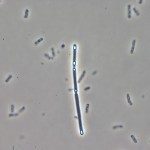Link to Pubmed [PMID] – 10079948
Bioorg. Khim. 1998 Dec;24(12):906-9
Fragments of the RNA polymerase beta-subunit genes from representatives of picoplankton of Lake Baikal were cloned using polymerase chain reaction (PCR), and the resulting recombinant clones were sequenced. An analysis of 93 clones revealed 40 different sequences. A comparison of these nucleotide sequences and the corresponding amino acid sequences deduced with their homologues from databanks confirmed the high conservation of the RNA polymerase beta-subunit region involved in the formation of the enzyme active site.

